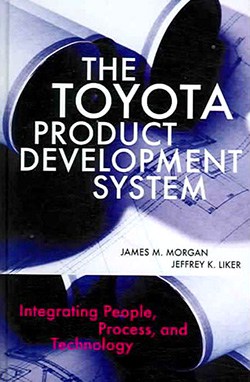So, profitability of the brand is not the main point. The main point is the average age and whether they already own Toyotas or not. The more they sell, the more they can impact young people. But if they have a few bad years because they decided to invest in development for other products, that’s fine. It doesn’t have to be year on year, justifying itself. Not that many companies are long-term thinking like that. They might judge that same product and say it has been three or four years and we’ve been losing money, why don’t we dump this product. Or we need to do something to revitalize this product now. They would get very anxious and there would be a lot of pressure.
Whereas Toyota is quite relaxed about it, because they know the placement of that product. They know the strategy. They know the purpose and they prioritize what they are going to spend more time on. That long-term thinking happens to be supported by the overall infrastructure of the company, which still is run in Japan, and still led today by a Toyota family member who has love for the company. He has a long-term vision and is pretty much immune personally to Wall Street and to pressure from stock-holders. He can ignore them and decide to do whatever he wants to do. There is no external board of directors to fire. So that helps a lot.
On the other hand, I started this new book on developing new leaders, talking about Jim Collins’ work on great companies. His companies are all American companies. A common denominator for great companies that stand out is that the CEO and senior leaders have a love for the company, a passion for the company and a passion for the customers. They care not just about profits but they care about the company as an entity in itself, like the way they would care about a child or about a great piece of art. They want the company to survive them. So it’s just not simply Toyota, it’s really any great company. In these great companies, the leaders have a passion and they care, so they make the short-term investment needed to be great for the long-term.
Colin: Yes, certainly it’s a great inspiration and you mentioned Jim Collins’ work, which I enjoy also. For us all to be taking that longer-term perspective to bring that right mindset to the business that we are trying to nurture.
In the study of Toyota, again, a great company, you and James Morgan distilled down your observations to thirteen key principles across three areas: process, skilled people, and tools and technology. The first principle I wanted to pick up on, and this is from the process area – is to establish customer-defined value to separate value-added from waste. Can you provide a thumbnail sketch of how Toyota separates customer-defined value from waste?
Jeff: Well, first of all, we wanted to emphasize that it starts with the customer. Then we wanted to emphasize that the lean concept of waste, which is anything that is not value added, depends completely on defining what is value added and value added can only be defined from the customers’ point of view. If you don’t really understand your customer, you have no way of prioritizing what is value-added and what is waste. One thing that really helps in Toyota is the chief engineer system, which we talk about in the book. By chief engineer, I mean the Chief Engineer at Toyota has a vision for the product. He actually has to understand what the customer wants and leads the overall architectural systems engineering and also delivery for timing, for profitability, for every aspect of the program. If the car is profitable, if it works well, without defects caused by design, the Chief Engineer is successful and Toyota will say, “It’s the Chief Engineer’s car.”
Now that puts sales and marketing in an interesting position, because in most companies that I know of, you find out what the customer requirements are by talking to sales and marketing. They will then give you the requirements; if you’re a program manager, you have to satisfy sales and marketing requirements. In Toyota’s case, the Chief Engineer is the customer of sales and marketing. In order for sales and marketing to be successful, they have to educate the Chief Engineer, and the Chief Engineer has a lot of power, so he decides what he wants to be educated on. He will either listen to them…or not.
At Toyota, if sales and marketing give the Chief Engineer a bunch of data that he thinks is irrelevant, he will just ignore it. He might say, “Let’s just go and see—line me up with a 100 customers in 50 different states and I want to talk to them.” Or, “I want to go to the dealers, I want to talk to the dealers, or I want to talk to the repair people to see what problems they have with the cars.” He gets a holistic understanding of the product: how’s it going to be used, what the customer base is like.
Then the Chief Engineer will usually summarize that in some simple diagrams and perhaps trade-off curves (e.g., trade-offs in the customers’ minds between styling and cost and fuel economy, etc.). Then once he has that, he issues a Chief Engineer concept paper that says, “Here is what this car needs to look like, here’s what it needs to do for the customer, here’s the cost target, here’s the timing.”
Now when he’s leading the project, he’s running around all over the place talking to suppliers, to purchasing, to product development engineers. Any difficult decision, any trade-off that they can’t make, the Chief Engineer can make on the spot. And he can also go into a meeting and ask, “Why are you working on this, it’s not a priority for the customer.” He translates what he sees, his vision of the customer, into technical requirements very clearly, very easily. The brake engineer knows that this is what the Chief Engineer expects of the breaking system. Once those requirements are known, then they are posted in the Obeya. Every meeting will start out with customer’s requirements: “Let’s remind ourselves what is it that we are trying to do, what is it that the customer wants.” That gives you a means during that meeting to say, “Wait a second, are we spending our time on the right thing?”

 The next competitive frontier is that you offer a product that is clearly superior to your customers. It solves your customer’s problems better, so they are willing to pay even extra for your product. If you patent that and own the intellectual property, then you just cut out your competitor. That happens in pharmaceuticals and high-tech businesses regularly. The real opportunity is to understand the customer and ask, “What are the problems the customer has that I can solve?”
The next competitive frontier is that you offer a product that is clearly superior to your customers. It solves your customer’s problems better, so they are willing to pay even extra for your product. If you patent that and own the intellectual property, then you just cut out your competitor. That happens in pharmaceuticals and high-tech businesses regularly. The real opportunity is to understand the customer and ask, “What are the problems the customer has that I can solve?”